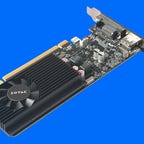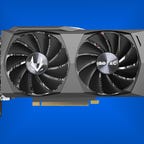
Inexpensive option for entry gaming and photo editing ($100-$350)
Nvidia GeForce RTX 3050
View details
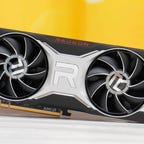
Top choice for 1080p and midrange photo editing ($300-$500)
AMD Radeon RX 6700 XT
View details
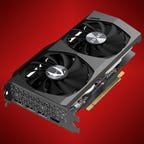
Most powerful option for low-power upgrades ($350-$600)
Nvidia GeForce RTX 3060
View details
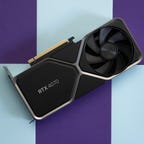
Best option for good 1440p, top quality 1080p, entry video editing ($500-$700)
Nvidia GeForce RTX 4070
View details
Entry 4K and good 1440p gaming, compute-intensive pro graphics ($700-$900)
AMD Radeon RX 7900 XT
View details
Good 4K gaming, pro video editing, 3D graphics ($700-$950)
Nvidia GeForce RTX 4070 Ti
View details
Whether you’re building a top-of-the-line gaming PC, or a lean machine for a creative workload, you’re going to need a good graphics card. Our top picks of the best GPUs to get right now have been out for a few years, but they’re still cutting-edge and will serve your needs just right. If you already know what you’re looking for then consider taking advantage of Amazon’s Prime Day sale. We’re rounding up all the Prime Day graphics card deals to shop for the event.
You may need newer cards to run optimization technologies like Nvidia’s DLSS, AMD’s FidelityFX and Intel’s XeSS, that help boost frame rates. The latest versions of these frame generation technologies work best with the latest generation GPUs — those built on Nvidia’s Ada Lovelace, AMD’s RDNA 3 or Intel’s Xe architectures. A newer gaming GPU is also likely to give you substantially better ray tracing performance than its last-gen counterpart. Plus, the newer cards have much better video encoding chops for smoother streaming.
You may be inclined to zero in on the specs like the manufacturer, GPU chip, amount and type of video memory, clock speeds, power requirements and other factors while picking the best graphics card for you. However, they’re imperfect predictors of how a particular graphics card will perform in your games or creative applications. To help you make the right choice for you, we’ve put together some suggestions based on our experience testing and using a big crop of GPUs.
In some cases, the card we tested was produced by the GPU company — Nvidia’s Founders Edition models, reference models of AMD graphics cards and Intel’s Limited Edition. In such case, we’ve recommended third-party cards from add-in board companies like Asus, MSI, Gigabyte and Zotac. The “editions” are manufacturer reference cards that often go out of stock and never come back, but the AIB models can hang around for years.
It can’t be stressed enough that, unlike a lot of products you shop for, GPUs require research based on your particular configuration because there can be real consequences for a bad fit, like system crashes and fried motherboards. There are some blanket caveats for each chipset: the newest Nvidia graphics cards require an adapter to work with most power supplies (they’re usually bundled), AMD cards have frequent reports of high-pitched whining and Intel’s still working out the kinks with its first generation of discrete GPUs.
Current generation GPU reviews
Best graphics cards
If you’ve got an old desktop with integrated graphics that don’t support the current versions of graphics programming interfaces such as DirectX 12 or Vulkan, or you have a game that won’t run unless it detects dedicated graphics memory (these have 2GB), or if you just want to make your Windows experience feel a little more snappy or smooth, a GT 1030-based card can help. It’s designed with lower power requirements than most other discrete GPUs, so it can fit in systems with small power supplies and compact designs. Unlike most gaming graphics cards, 1030-based cards can be low-profile and take up just a single slot for connectivity and are quieter because they only require a single fan.
Don’t expect to game with the GeForce GT at 1080p — 720p at best, unless a game is very lightweight. But Fortnite, CS:GO, League of Legends and other popular multiplayer games generally fall under the “can play on a potato” umbrella, so casual players don’t need to worry as much if they’re your go-to’s. In some cases, games may simply go from unplayable to a little less unplayable. If you do want to play games, spring for versions with DDR5 memory, not DDR4; it can make a noticeable difference. That’s why you’ll see some price variations. For a simple speedup, the cheapest decent one I’ve seen was $82, although prices can fluctuate.
For gaming, the RTX 3050 is a fine gets-you-in-the-door GPU, providing good 720p and decent 1080p performance. Since much basic photo editing still isn’t very GPU-intensive, a fast, high-core-count CPU still gives you a lot more performance value for the money than a higher-powered graphics card. The GPU does matter for the experience and smooth display rendering, but for smallish images and single-screen editing, you shouldn’t have any issues. The GPU is being used increasingly to accelerate AI-based features, like automagic object selection, so it’s worth getting a more recent card — especially since many of the older GTX models have left the “older so it’s cheaper” phase and entered that “going out of stock so let’s jack up the prices because of scarcity” phase. At the moment, the RTX 3050 is the best budget graphics card to get.
For a little less, at $308 there’s also the better-performing Intel Arc A750. Despite Intel’s frequent updates to the drivers, though, I’m hesitant to make a blanket recommendation; Intel’s new to the discrete GPU market, and its cards seem to be experiencing first-generation growing pains. Also, you really want resizable BAR support on your system and it has higher power requirements than a typical entry-level card, which means it’s not necessarily suited to older or entry-level PC upgrades. If you’re feeling adventurous, at least there aren’t a raft of third-party options to choose from — just ASRock and Intel’s own Limited Edition model.
The RTX 3050 card I tested was an EVGA model, and EVGA has since left the GPU biz.
This one’s a bit difficult to call at the moment since the current generation of technologies from AMD and Nvidia for this class of card hasn’t been announced yet — although I think both are imminent. You can get last-gen cards that will perform perfectly well for these uses, and possibly older, but I hate making those recommendations without knowing what the prices will be on the newer cards, especially since the newer Nvidia Ada and AMD RDNA 3 architectures add quite a bit over their predecessors.
The AMD RX 6700 XT is still a good meat-and-potatoes card if you need to buy something now, pretty much outperforming the rest in its price class. The AMD cards tend to get complaints about audible whining, and I admit I hear it myself periodically, so if that’s a potential issue then the more expensive RTX 3060 Ti is probably a good bet as well.
A lot of old or low-end gaming PCs, as well as compact systems, can’t handle the size or power requirements of many of the newer GPUs. The RTX 3060 is the highest-end GPU that can fit usually into dual-slot systems which only have room for short (one- or two-fan) cards and with power supplies of 500 w or less. That doesn’t necessarily account for overclocking, so if you’re planning on pushing it to the limit, make sure the card you get — when overclocked — combined with your CPU’s power draw won’t exceed the cooling or power limits of your PC.
The RTX 3060 card I tested was an EVGA model, and EVGA has since left the GPU biz.
The RTX 4070 is one of the most flexible performers on the market, with gaming performance that spans 1080p through entry 4K — although for decent 4K performance, you (and your games) need to take advantage of Nvidia’s DLSS 3 optimization technology. DLSS 3 performs much better than the previous generation, and support for it is one of the things that makes the RTX 40- series notably better than its predecessor.
While this Nvidia card isn’t cheap, the price is also not at the top of the range for its competitive class either.
The RX 7900 XT isn’t always faster than competitor RTX 4070 Ti, but it has more memory for the same money (20GB vs. 12GB), which gives it a leg up for games and applications that can take advantage of it. AMD’s RX 7000 series of GPUs also have DisplayPort 2.1 connections, while Nvidia’s are still using DP 1.4. While there aren’t a lot of DP 2.x monitors yet, the standard supports higher refresh rates at 4K than earlier specifications.
The RTX 4070 Ti isn’t excessively more expensive than the 4070 and it provides noticeably better performance. It’s a lot bigger and draws a lot more power as well — unsurprising, since it began life as a stripped-down RTX 4080 — which makes it a little less flexible than the RTX 4070 as a card that I’d consider a general recommendation. It’s also a lot smaller, cheaper and less power-hungry than the RTX 4080 and 4090. That combination makes it my favorite overall, although the 4070 is my top recommendation.
For just about everything, the RTX 4090 is the fastest consumer GPU on the market, with a big enough 24GB frame buffer to handle high-res games and video editing as well as streaming. If you have the budget, this is the Nvidia card to get.
The RTX 4080 is a cheaper alternative in the $1,200-$1,600 range, although it’s roughly the second fastest currently on the market and it’s tempting to drop to the much less expensive 4070 Ti. The Radeon RX 7900 XTX is a better choice than the 4080 for compute-intensive pro graphics and can outpace the RTX 4080 on some games, and supports higher-bandwidth DisplayPort 2.1. It still lags a lot of Nvidia cards for ray tracing. It can be found for as low as $1,000, which may be worth the tradeoff.
- Power requirements: Always check the power needs of a card against your power supply’s output. Don’t forget to take the other cards and devices in your system into account concerning power usage.
- The most powerful GPU on the planet won’t make a difference if your CPU is the bottleneck (and vice versa) — think overkill.
- You’ll see a lot of price variation across cards using the same GPU. That’s for features such as overclocking, better cooling systems or flashy (literally) designs.
- Dual-card setups are usually more of a pain than they’re worth. Video editing is usually the exception, depending upon application support.
- If you want a card for content creation, game benchmarks aren’t usually representative. To research those, start by running a search on “workstation GPUs” or, for example, “best GPU for Premiere.” It’s important to match the GPU to the application because Nvidia RTX A-series GPUs (the workstation GPUs formerly known as Quadro), for example, are generally more powerful than their AMD Radeon Pro or WX series equivalents. Application developers who are tight with Apple — which doesn’t support Nvidia GPUs — optimize their applications for AMD GPUs. The biggest example of this is Blackmagic Design’s DaVinci Resolve video editor.
- For photo editing, it may no longer suffice to use a low-end or middling graphics card, although it depends on your software. With the latest generations of Photoshop and Lightroom, Adobe has begun to expand its use of AI-related technologies in meaningful ways. For instance, Photoshop’s Replace Sky and Neural Filters can take advantage of GPU hardware designed to accelerate AI to speed them up, such as the Tensor cores in Nvidia’s RTX cards. If you don’t have at least 32GB of memory, graphics applications may get a bigger boost from upgrading that before the GPU, unless the graphics card is really old.
- For video editing, the amount of memory on the card can have a big impact on real-time performance as you work with higher-resolution video (4K and up).
- Running games at 4K requires significantly more video memory than 1440p or lower, at least 8GB.
If you’re sensitive to screen artifacts caused by a disconnect between the rate at which your monitor updates and the frame rate at which you’re playing, or you’re interested in proprietary technologies like Nvidia’s Latency Analyzer to help improve your gameplay by reducing lag, then you should definitely at least look into what each of them offers. Otherwise, get the appropriate GPU for your needs and work with what you get.
Shadow of the Tomb Raider gaming test (1440p)
A750 LE 80RTX 3060 82RTX 4070 163RTX 3080 Ti 167RX 7900 XT 182RTX 4070 Ti 195RX 7900 XTX 209RTX 4080 220RTX 4090 235
Shadow of the Tomb Raider gaming test (4K)
RTX 4070 84RTX 3080 Ti 97RX 7900 XT 99RTX 4070 Ti 103RX 7900 XTX 125RTX 4080 134RTX 4090 181
Guardians of the Galaxy (1440p at maximum quality with ray tracing)
RTX 3060 45A750 LE 69RX 7900 XT 83RTX 4070 89RX 7900 XTX 93RTX 3080 Ti 102RTX 4070 Ti 109RTX 4080 136
3DMark Time Spy
RTX 3060 8,628A750 LE 13,018RTX 4070 18,013RX 7900 XTX 19,760RTX 4070 Ti 22,731RX 7900 XT 24,814RTX 4080 28,275RX 7900 XTX 29,413RTX 4090 35,467
3DMark Fire Strike Ultra
RTX 3060 5,269A750 LE 6,984RTX 4070 10,413RTX 3080 Ti 12,635RTX 4070 Ti 13,707RX 7900 XT 16,879RTX 4080 17,619RX 7900 XTX 19,760RTX 4090 24,407
3DMark Speed Way (DX12 Ultimate)
RTX 3060 2,157A750 LE 2,366RTX 4070 4,479RX 7900 XT 4,534RTX 4070 Ti 5,429RX 7900 XTX 5,891RTX 4080 7,168RTX 4090 9,813
3DMark DXR (DirectX ray tracing)
RTX 3060 19.47A750 LE 29.57RX 7900 XT 42.06RX 7900 XTX 49.16RTX 4070 51.82RTX 3080 Ti 54.96RTX 4070 Ti 67.95RTX 4080 85.01RTX 4090 136.05
Procyon Video
A750 LE 7,242RTX 3060 7,342RX 7900 XT 8,259RTX 4070 8,383RTX 4070 Ti 8,479RX 7900 XTX 8,494RTX 3080 Ti 8,792RTX 4080 9,250RTX 4090 9,678
SpecViewPerf 2020 SolidWorks (4K)
A750 LE 50.64RTX 4070 154.28RX 7900 XT 165.46RX 7900 XTX 184.8RTX 4070 Ti 189.64RTX 3080 Ti 191.52RTX 4080 233.84RTX 4090 304.66
Configurations
| Custom PC | Microsoft Windows 11 Pro (22H2); 3.2GHz Intel Core i9-12900K; 32GB DDR5-4800; 2x Corsair MP600 Pro SSD; Corsair HX1200 80 Plus Platinum PSU, MSI MPG Z690 Force Wi-Fi motherboard, Corsair 4000D Airflow midtower case |
|---|
 synnbiob
synnbiob


